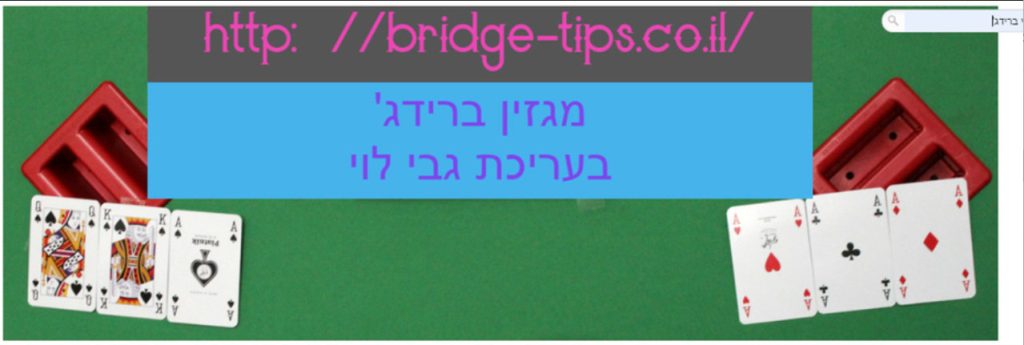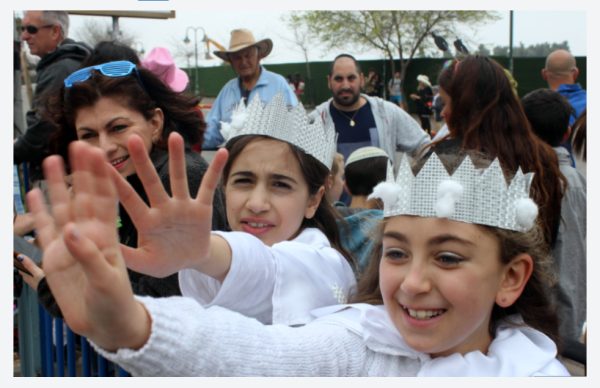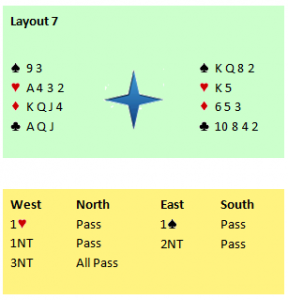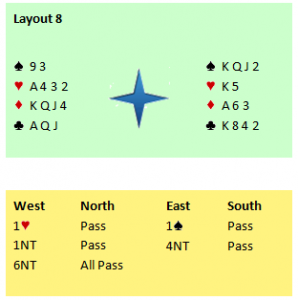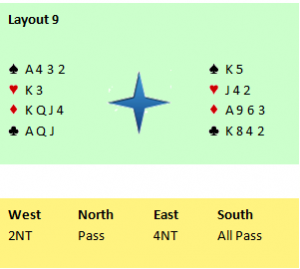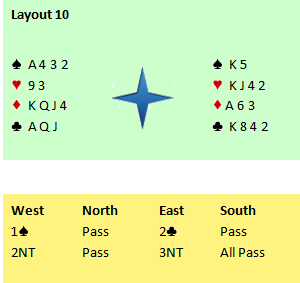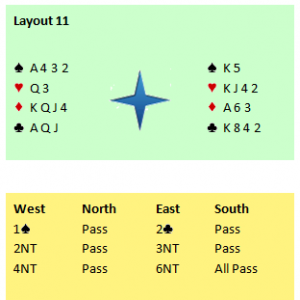טיוטה מיום 26.07.2011 פורסמה ביום 18.03.2017; עודכנה ביום: 21.03.2025
אנו שמחים לפרסם את הכתבה החמישית והאחרונה בנושא "הערכת היד – כיצד לפתוח עם ידיים מאוזנות".
הכתבה החמישית עוסקת בהעלאות כמותיות – האם למשיב יש יד מקסימלית?
הכתבות הן בשפת המקור=אנגלית. בהמשך אעלה את התרגום בעברית וכתבות נוספות.
שים לב: השיטה הנהוגה בבריטניה, מקום מושבו של מחבר הכתבות, הינה NT חלש, כלומר פתיחת 1NT עם ידיים בטווח של 12-14HCP.
(בתודה ליואל ברקן)
הכתבה המלאה:
HAND EVALUATION 5
Opening with Balanced Hands
Part 5 of 5
by Bernard Magee
QUANTITATIVE RAISES
One final aspect of no-trump bidding is the use of quantitative raises: 2NT invites a game in no-trumps and 4NT (directly after a previous no-trump bid) invites a slam. Both quantitative raises work in the same way: they ask the bidder's partner to bid on if he has a maximum hand for his bidding thus far.
You use a quantitative bid when adding your points to the maximum number of points your partner can hold will reach your target: 25 points for 3NT or 33 points for 6NT. The most common example is when you hold 11 points after a 1NT opening (12-14): adding 11 to partner's maximum (14) gives 25 points, so you should invite partner to game by bidding 2NT
In Layout 7, West shows 15-17 HCP and you, East, have 8 HCP. Adding that to partner's maximum (17) gives 25, so there is a chance for game and you raise to 2NT. With 17 HCP, West has the maximum and therefore accepts your invitation and bids 3NT.
In Layout 8, the West hand remains the same but you, East, have 16 points. Adding that to partner's maximum (17) you get 33 points, which means there is a chance for 6NT. This time you jump to 4NT to invite the slam and, since West has the maximum 17 points, he raises to 6NT.
In Layout 9, East has 11 points, but since West has shown 20-22 for his opening 2NT, the partnership might still have 33 points if West is maximum. Therefore East invites slam by bidding 4NT, but this time West has the minimum strength for his bid and so passes.
There is only one exception to the rule of quantitative bids and that is when the 2NT rebid shows 15-19 points: because the range of this bid is so wide you cannot invite slam in the usual way. As is often the case in bridge, you should bid like a pessimist! You respond as if your partner had 15-17 points, bidding 4NT to invite a slam with 16 points. Clearly if partner holds 17, 18 or 19 points, he would accept your invitation gladly. With only 14 points, you should simply bid 3NT; it is then your partner's job, if he has 19 points, to bid 4NT himself. For example:
For example:
In Layouts 10 and 11, East has 14 points. Since partner's 2NT rebid in each case shows 15-19 points, there is some chance of a slam, but it is not up to East to ask. He simply raises to 3NT, which, inLayout 10, West passes – he has just 17 points. In Layout 11,holding 19 points, West should invite a slam by bidding 4NT. This shows he holds 19 points, so now East adds his points and if the total is enough for slam he bids it. Here 14 + 19 = 33, so East jumps to 6NT.
המקור: mrbridge
לקישור לכתבה " פתיחה עם ידיים מאוזנות " – לחץ כאן
לקישורים לשיעורים ב-youtube:
לקישור לשיעור " How to bid balanced hands " – לחץ כאן
לקישור לשיעור " Strong Balanced Hands " – לחץ כאן
לקישור לשיעור " Bidding Balanced hands using Benji Acol " – לחץ כאן
לקישור לשיעור " Learn to Play Bridge: Opening Balanced Hands from 12 to 27 Points! Learn the Notrump Opening Ladder " – לחץ כאן
לקישור לטבלת " Balanced hand opening bids and rebids " – לחץ כאן
בברכה,
גבי לוי
 מגזין ברידג' בניהול ובעריכת גבי לוי
מגזין ברידג' בניהול ובעריכת גבי לוי
